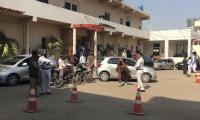Districts in Afghanistan and falling like ninepins. The Afghan Taliban has already taken control of 18 out of Afghanistan’s 34 provinces – and without much resistance.
The Afghan National Army, as expected, is not fighting – maybe even surrendering. Why would ANA fight, for whom and with what backing? They have no cause, no commander and no coalition supporting them. The much-talked-about militias' induction by Kabul amounted to nought. Talk of well trained and well equipped commandos of the Afghan army fighting to push back the advancing Taliban is proving to be nonsense.
The coalition supported Kabul setup seems to be evaporating. With the Taliban controlling all Afghan borders – and hence revenues – and the provincial government collapsing, the Ghani government is all but gone. Multiple pressures mount on Kabul as Afghans fleeing from Kunduz, Herat and other areas arrive to take refuge. Changing the military commander, appointing a new finance minister and arriving in Mazar-e-Sharif are all desperate attempts by Ashraf Ghani to salvage a situation already out of his control.
His American supporters have been unkind to him by not ‘advising’ him to step down and let others engage with the Taliban.
One wonders what delusions Washington harboured about the Kabul setup. Pakistani interlocutors privately insist US officials are genuinely naive and also in a tight spot. How could they ask Ashraf Ghani to leave without the Taliban agreeing to some conditions including a representative interim setup etc? The Kabul setup argued that they acceded to the Taliban condition of freeing prisoners but the Taliban did not respond to their demands. We have the answer now. The Taliban have walked into 170 districts and released prisoners, and handed them weapons to fight.
Meanwhile, Ghani’s calculation – some argue – has been that the Taliban will go for massive bloodshed and human rights violations, annoying the West sufficiently to force the US and others to return to Afghanistan. That seems the most likely scenario. US President Biden has repeatedly emphasised, though, that there is no returning of American forces to Afghanistan and that he took the right decision to leave.
Biden seems to be a man who learnt from the unabated blunders the US has made over the decades. Washington had demanded the self-destruct clause of no Taliban to be included in the Bonn Agreement. Even worse, when Hamid Karzai returned to Afghanistan and made the wise decision that his government would engage the 'good Taliban', he was reprimanded sufficiently by some US State Department employees to then withdraw his statement. Afghanistan society’s political hell – initiated in the late seventies with the Soviet invasion – continued into the eighties with the US, Pakistan and the international community producing with Afghan participation an elaborate ‘international jihad’.
So fast forward to where we are today. The Taliban are appearing stronger than 2001 when the US forces landed to conquer the Taliban and Afghanistan.
In the last two days, regular opinion writers published pieces arguing that today’s Taliban advances were a truth foretold. For example, Fred Kaplan’s column, 'Biden’s Optimistic Promises are Collapsing', in slate.com says: "the only thing surprising about the Taliban’s rapid advance is that anyone is surprised.” Vali Nasr, a former senior policy advisor at the State Department in Obama’s administration, has also questioned the state of affairs in Afghanistan ever since the US forces landed there. “The rapid rate at which the #Taliban are taking over #Afghanistan says so much about how we were oversold time and again on the progress US military and Afghan security forces were making. It was a house of cards, [the] Taliban must have been winning all along,” Vali Nasr tweeted.
Those who are shocked themselves make for a shocking phenomenon. The delusional reality created by many in the Western world and those allied with them or opposed to the Taliban and to Pakistan, with India leading this plank, have all been busy through social media to make vacuous policy statements seem as the reality. A whole architecture was constructed around this imagined reality: that the Afghans are all fed up with the Taliban, that they are generally supporters of non-Taliban groups, that the Taliban are nothing but a foreign supported group. These comfortable myths were projected widely as reality.
The discipline of fact checking was made subservient to the preferences of the US, Nato troops and many other world capitals. Personally, I loathe the way of the Taliban when it comes to their track record on human rights, on women’s rights, on humanism etc. Yet the fact that they do have support among sections of the Afghan people cannot be denied.
By and large the Western media, some exceptions like Kathy Gannon etc notwithstanding, went along with their government’s positions – as reflected by the Afghanistan-based ISAF forces. Indian media mostly opted blindly for the Indian government’s concocted story: the Taliban are ISI’s men. It too was voluntarily blinding oneself to the reality that was unfolding.
The 2009 Carnegie report, 'Taliban’s Winning Strategy in Afghanistan', comprehensively documented some facts about the Taliban: “A misunderstanding of the insurgency is at the heart of the difficulties facing the International Coalition in Afghanistan. The Taliban are often described as an umbrella movement comprising loosely connected groups that are essentially local and unorganized. On the contrary, this report’s analysis of the structure and strategy of the insurgency reveals a resilient adversary, engaged in strategic planning and coordinated action.
"The Taliban are a revolutionary movement, deeply opposed to the Afghan tribal system and focused on the rebuilding of the Islamic Emirate. Their propaganda and intelligence are efficient, and the local autonomy of their commanders in the field allow them both flexibility and cohesion. They have made clever use of ethnic tensions, the rejection of foreign forces by the Afghan people, and the lack of local administration to gain support in the population. In so doing the Taliban have achieved their objectives in the South and East of the country, isolating the Coalition, marginalizing the local Afghan administration, and establishing a parallel administration (mainly to dispense Sharia justice and collect taxes). In recent months, a more professional Taliban have succeeded in making significant inroads by recruiting from non-Pashtun communities.
"These developments, and the strength of the insurgency makes the current Coalition strategy of focusing its reinforcements in the South (Helmand and Kandahar) unwise to say the least. The lack of local Afghan institutions there will require a long-term presence and therefore a need for even more reinforcements in the coming year. Meanwhile, the pace of Taliban progress in other provinces (see map, inside front cover) far outstrips the ability of the Coalition to stabilize the South. The Coalition should change the priorities of its current strategy, shifting resources to stop and reverse the Taliban’s progress in the North, while reinforcing and safeguarding the Kabul region or risk losing control of the entire country.”
At present, from most cities there is no report of any major resistance from the Afghan forces nor is there any report of any major bloodshed or of major refugee outflow from any of the Taliban-controlled cities. Equally, there aren't for now any reports of refugee outflow into any neighbouring countries either. How long this lasts is yet to be seen but as of now the Taliban seem to be comfortably observing the practice of 'enter and control' in most Afghan cities.
The fast-changing ground situation in Afghanistan is essentially making the Doha talks redundant. Although a two-week period had been given to the Kabul government on their request to work out the next steps for a political settlement, it appears that the situation on the ground may not require another Doha round. It is being made clear to the Taliban at Doha that the international community will not tolerate any human rights violations, no shutting down of any schools, no stopping women from working and no entering into people's houses.
The most likely scenario in the coming days will be that the international community will closely watch the situation on the ground and if the Taliban arrive around Kabul without violence and without a military fight they will be recognised by the international community. How the Taliban honour their commitment of setting up a multi-ethnic representative government is to be seen.
The writer is a senior journalist.
Email: nasimzehra@gmail.com
Twitter: @nasimzehra
We are haunted by systemic inefficiencies that threaten to dismantle this fragile ascent
Misinformation runs rampant, webbed into political rhetoric, social commentaries, viral posts, and group chats
Difference lies in institutions governing these regions, SK and Arizona built inclusive institutions, while their...
At heart of our problems is misalignment of our efforts with our objectives
Studies have established that most effective interventions for improving quality of education is to train teachers
For Pakistan, 2025 must be year of decisive action and vision







